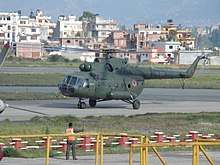Nepalese Army
| Nepalese Army | |
|---|---|
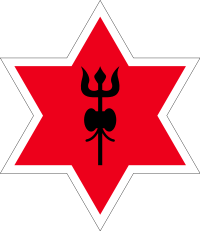 Roundel of the Nepalese Army | |
| Active | 1768 – present (249 years) |
| Country |
|
| Allegiance | Government of Nepal |
| Type | Army |
| Size | 95,000 (62,000 reserve)[1] |
| Garrison/HQ | Kathmandu |
| Motto(s) | It's better to die than to be a coward |
| Anniversaries | Maha Shivaratri |
| Engagements |
Battle against Mir Qasim 1763 Battle of Pauwa Gadhi against Captain Kinloch, 1767 Battle of Kirtipur Battle of Kathmandu Battle of Bhaktapur Limbuwan-Gorkha War Gurkha-Sikh War First and Second Sino-Nepalese War Last Nepalese-Tibetan War Anglo-Nepalese War World War I (Casualties) World War II (Casualties) Nepalese Civil War |
| Commanders | |
| Current commander | General Purna Chandra Thapa |
| Notable commanders |
Kalu Pande Abhiman Singh Basnet Damodar Pande Amar Singh Thapa |
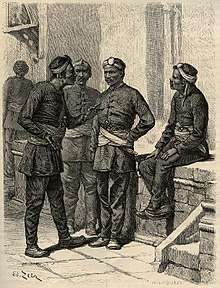
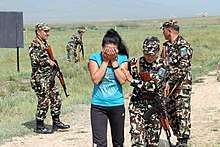
The Nepalese Army (Nepali: नेपाली सेना) or Gorkhali Army (Nepali: गोर्खाली सेना) is the military land warfare force of Nepal and a major component of the Military of Nepal. Service is voluntary and the minimum age of recruitment is 18 years. The army was formerly known as The Royal Nepalese Army (RNA) during the monarchy period in Nepal. It was renamed the Nepalese Army on 28 May 2008 after the abolition of the 238-year-old Shah dynasty rule.
History
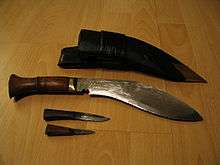
Nepal unification campaign was a turning point in the history of the Nepalese army. Since unification was not possible without a strong army, the management of the armed forces had to be exceptional. Apart from the standard Malla era temples in Kathmandu, army being organized in Gorkhas, technicians and experts had to be brought in from abroad to manufacture war materials. After the Gorkhali troops captured Nuwakot, the hilly northern part of Kathmandu (Kantipur) in the year 1744, the Gorkhali armed forces came to be known as the Royal Nepalese Army.
Their gallantry, sincerity and simplicity impressed even their enemy so much that the British East-India Company started recruiting Nepalese into their forces. Since the British had fought against then RNA, which was till that time, still colloquially known as "Army of Gorkha" or "Gorkhali" army, the British called their new soldiers "Gurkhas". Sikh and Gurkha army 's war took place in 1809 which is known as Gurkha-Sikh War. The Indian army, after gaining their independence from the British, started calling them "Gorkha". In 1946, the Royal Nepalese Army troops were led by Commanding General Sir Baber Shamsher Jang Bahadur Rana at the Victory Parade in London.[2]
The Gurkha Rifles existing in India and Britain are part of foreign military organizations where Nepalis are recruited. The NA are rightfully the true heir of the title of "The original Army of the Gorkha".
Prior to 2006 the Nepalese Army was known as the Royal Nepalese Army and was under the control of the King of Nepal. Yet following the Loktantra Andolan (People's Movement for Democracy) on May 18, 2006 a Bill was passed by the Nepalese parliament curtailing royal power, this included renaming the army.[3]
In 2004 Nepal spent $99.2 million on its military (1.5% of its GDP). Since 2002 the RNA had been involved in the Nepali Civil War they were also used to quell the pro-democracy protesters in April 2006 Loktantra Andolan. India is the largest arms and military hardware supplier.
Organization
The Nepalese Army has about 95,000 infantry army and air service members protecting the sovereignty of Nepal. On August 2018, The Himalayan Times estimates total army forces to be around 96,000[4] while The Kathmandu Post estimates it to be 92,000.[5]
Supreme Command
The position of the Supreme Commander of the Nepalese Army is the President of the Federal Democratic Republic of Nepal. Until 2006, the King of Nepal (monarchy abolished) was in control of all military forces in the country. The National Army was renamed from Royal Nepalese Army to Nepalese Army after the recent national conversion from a monarchy to a republic on 4th Jestha 2063 B.S.
The National Defence Council
This Council has seven members, the Prime Minister, the Defence Minister, the Chief of the Army Staff, Foreign Minister, Finance Minister, Home Minister and the Chief Secretary.
The President of Nepal is the Supreme Commander-In-Chief.
Divisions
The Nepalese Army is divided into eight divisions, one each in the seven states and one in the Kathmandu Valley.
In addition there are at least 7 independent units:
- Army Aviation Directorate
- Special Forces Brigade
- VVIP Security
- Artillery Brigade
- Signals Brigade
- Engineers Brigade
- Air Defense Brigade
Women Participation in Nepal Army
The unofficial participation of women in Nepal Army was first during Anglo Nepal War on battle of Nalapani. Battle of Nalapani was the first battle of the Anglo-Nepalese War of 1814–1816, fought between the forces of the British East India Company and Nepal, then ruled by the Gorkha Kingdom. Nepalese women were heavily involved in this battle supporting the male Gurkha warriors. With no automatic weapons in hands Nepalese women fought with British troops with stones and woods. According to Nepal Army YouTube channel "Nepali Army" programme Nepali Senama Mahila Sahabhagita (documentary)[6] - Episode 405, the official participation of women in Nepal Army started in 2018 B.S in the post of Nurse. The timeline of official women's participation in Nepal Army is as follow:
- 2018 B.S = Captain Gyani Shah as Nurse
- 2022 B.S = Parachute folding women team
- 2026 B.S = First women Para Jumper Leutinant Annapurna Kunwar
- 2026 B.S = Introduction of women doctor
- 2055 B.S = Introduction of women in law affairs
- 2056 B.S = Introduction of women as UN Peacekeeping mission
- 2061 B.S = Introduction of women engineers and other technicians
Notable Women Officers In Nepal Army
- Brigadier General Dr. Radha Shah = First women to become Brigadier General of Nepal Army
- Brigadier General Dr. Narvada Thapa = First women staff of Nepal Army to get doctorate degree(P.Hd)
- Colonel Dr. Sarita K.C = First Nepalese army personnel to join UN Peacekeeping mission(UNIFIL)
- Major Kriti Rajbhandari = First women observer military liaison officer from Nepal Army
- Major Geeta Gurung = First unit commander in UN Mission from Nepal Army
- Colonel Yvetta Rana = First women officer of Judge Advocate General Department of Nepal Army
- Lieutenant Colonel Sovana Rayamajhi = First women officer to join IT Department of Nepal Army
- Major Niru Dhungana = First batch of women military pilot
- Major Anita Ale Magar = First batch of women military pilot
- Major Shristhi Khadka = First women commander of Nepal Army
Operations
The Primary role of the NA is to defend the territorial integrity, sovereignty and independence of Nepal. Their secondary role is to provide assistance to the Civilian Government of Nepal in the maintenance of internal security. Other duties include humanitarian assistance/disaster relief operations, assisting in national development, nature conservation efforts and participation in international peacekeeping mission.
Foreign Involvements
- Royal Nepalese Army in Indian Sepoy Mutiny
- Royal Nepalese Army in The First World War 1914–1918
- Royal Nepalese Army in Waziristhan War
- Royal Nepalese Army in Afghan War −1919
- Royal Nepalese Army in The Second World War
- Royal Nepalese Army in Hyderbad Action – 1948
Domestic Operations
Disarmament of the Khampas – 1974
In 1974, the then Royal Nepalese Army (RNA) was mobilized to disarm the Tibetan Khampas, who had been using Nepalese soil as a base to engage in guerilla warfare against the People's Liberation Army in the Tibetan Autonomous Region of China. The Khampas operated mainly from a base secretly established at Mustang in northwest Nepal. The RNA, under diplomatic pressure from China and the international community, moved nine infantry units toward Mustang, and gave the Khampas an ultimatum to either disarm themselves and surrender, or face attack. The terms and conditions of their surrender were that they would be given Nepalese citizenship, land, and money, and free schooling for their children. The Khampa commander, General Wangdi, agreed to surrender but eventually fled the camp. He was later killed by RNA forces in Doti, in far western Nepal, while trying to loot a Nepal Police post. This was the first time the RNA had mobilized domestically in such large numbers.
International Operations
The Nepalese Army has contributed more than 100,000 peacekeepers to a variety of United Nations-sponsored peacekeeping missions such as:
- United Nations Interim Force in Lebanon (UNIFIL),
- UNOSOMII the United Nations Protection Force (UNPROFOR), UN Operational Mission Somalia II,
- MINUSTAH the United Nations Mission in Haiti.
- UNAMSIL – Currently, Nepal is sending an 800-man battalion to serve in the peacekeeping mission in Sierra Leone (UNAMSIL).
- UNMIS – The Nepalese Army has sent a protection company of 200 personnel in United Nations Mission In Sudan. The Redeployment Coordination HQ at Kassala is also manned by the Nepalese contingent. The RCHQ was intended to monitor withdrawals from the eastern sectors of the UNMIS area in accordance with the Sudan Comprehensive Peace Accord.
U.S./Nepal military relations
The U.S.-Nepali military relationship focuses on support for democratic institutions, civilian control of the military, and the professional military ethic to include respect for human rights. The US would support Nepal with arms, ammunition and additional commandos and soldiers if war began with its neighbouring China but resist giving any support if war broke out with India as in is an important ally to US in the indo pacific against China and has also signed COMCASA with US in the 2+2 meeting in September 2018. Both countries have had extensive contact over the years. Nepali Army units have served with distinction alongside American forces in places such as Haiti, Iraq, and Somalia.
U.S.-Nepali military engagement continues today through IMET, Enhanced International Peacekeeping Capabilities (EIPC), Global Peace Operations Initiative (GPOI), and various conferences and seminars. The U.S. military sends many Nepalese Army officers to America to attend military schooling such as the Command and General Staff College and the U.S. Army War College. The IMET budget for FY2001 was $220,000.
The EIPC program is an inter-agency program between the Department of Defense and the Department of State to increase the pool of international peacekeepers and to promote interoperability. Nepal received about $1.9 million in EPIC funding.
Commander in Chief, Pacific (CINCPAC) coordinates military engagement with Nepal through the Office of Defense Cooperation (ODC). The ODC Nepal is located in the American Embassy, Kathmandu.
Bases
- Kathmandu Army HQ
- Panchkhal Military Base (UN Peacekeeping Training Center)
Major Base Camps are located in all 77 districts of Nepal with at least 20 major base camps and 9500 Army in each districts.
Schools
- Nepalese Army Command and Staff College, Shivapuri
- Nepalese Army War College, Nagarkot
- Nepalese Military Academy, Kharipati
- Nepalese Army Recruit Training Center, Trishuli
- Nepalese Army Jungle Warfare School, Amlekhgunj
- Nepalese Army High Altitude and Mountain Warfare School, Mustang
- Nepalese Army Intelligence School, Kharipati
- Nepalese Army Logistics School, Chhauni
- Birendra Peace Keeping Operation Training Center, Panchkhal
- Nepalese Army Para Training School, Maharajgunj
- Nepalese Army EME school, Kharipati
Units
There were initially six divisions called Pritana (Nepali: पृतना) in Nepal. Recently, two divisions are added. There is one head of the division known as Pritanapati who is ranked Major General.
| Insignia | Name | Headquarters | Motto | Founded Year | First General Officer Commanding (GOC) | Current General Officer Commanding (GOC) | Subordinate Unit(s) |
|---|---|---|---|---|---|---|---|
| Eastern Division | Itahari | Rastra Rakshya Param Kartabya | January 29, 2003 (2059 Magh 15 B.S) | Maj. Gen. Pradip Pratap Bam Malla | Maj. Gen. Sameer Shahi | ||
| Mid Eastern Division (proposed) | Province No. 2 | ||||||
| Mid Division | Hetauda | Atal Bhakti Desh Prati | November 16, 2004 (Marga 01, 2061) | Maj Gen Thakur Subba | Maj Gen Subarna Bahadur Shah | ||
| Valley Division | Narayanhiti Palace, Kathmandu | Shanti Surakshya Sarbada | May 19 2003 (2060 Jestha 5) | Maj Gen Kiran Shumsher Thapa | Maj. Gen. Shashi Chandra Bahadur Singh | ||
| Western Division (Formerly Central Division) | Pokhara | Rakshya Nai Dharma Ho | February 13, 2003 (Falgun 1, 2059) renamed on September 17, 2004 |
Lt Gen Chitra Bahadur Gurung | Maj Gen Kaji Bahadur Khatri | ||
| Mid Western Division (proposed) | Province No. 5 | ||||||
| North Western Division (Formerly Western Division and Mid Western Division) | Surkhet (Formerly at Nepalganj) | Sadaiba Samarpit Desh Prati | 29th Nov, 2001 (14th Mangsir, 2058) renamed on 23rd Oct, 2005 (6th Kartik, 2062) as Mid-Western Division renamed as the North Western Division on 16th July, 2017 (1st Shrawan, 2074) |
Maj Gen Sadip Bahadur Shah | Maj Gen Karmendra Bikram Limbu | ||
| Far Western Division | Dipayal | Bhakti Nai Sakti Ho | July 5, 2004 (Ashad 21, 2061) flag raised on May 1, 2005 (Baisakh 18, 2062) |
Maj Gen Rajendra Thapa | Brig Gen Jhankar Bahadur Kadayat |
The first four army units of the Nepalese Army are Shreenath, Kali Baksh (Kalibox), Barda Bahadur and Sabuj companies in August 1762 by the King Prithvi Narayan Shah. The Purano Gorakh Company was founded on February 1763 is the fifth army unit of Nepal by its founding date.[9]
- Shree Nath Battalion – established 1762
- Shree Kali Buksh Battalion (Engineers) – established 1762
- Shree Barda Bahadur Battalion – established 1762
- Shree Sabuj Battalion – established 1762
- Shree Purano Gorakh Battalion – established 1763
- Shree Devi Datta Battalion – established 1783
- Shree Naya Gorakh Battalion – established 1783
- Shree Bhairavi Dal Battalion – established 1785
- Shree Singhanath Battalion – established 1786 (Commando)
- Shree Shreejung Battalion – established 1783
- Shree Ranabhim Battalion – established 1783
- Shree Naya Shree Nath Battalion – established 1783
- Shree Vajradal Company – established 1806
- Shree 'The Famous' Mahindra Dal Battalion -established 1844 A.D -1901 B.S.
- Shree Rajdal Regiment (Artillery) (Currently has expanded to three additional independent Artillery regiments)
- Shree Ganeshdal Battalion – established 1846 – signals and communications
- Shree Nepal Cavalry – established 1849 – Household Cavalry ceremonial unit since 1952
- Shree Kali Prasad Battalion (Engineers) – established 1863
- Shree Bhairavnath Battalion – established 1910 – (Parachute Battalion)
- Shree Bhagvati Prasad Company – established 1927
- Shree Khadga Dal Battalion - established 1937
- Shree Parshwavarti Company – established 1936 – served as PM's Body Guard unit and disbanded 1952
- Shree Gorkah Bahadur Battalion – established 1952 (best infantry unit of NA, then was established for special duty of Royal Guards).
- Shree Jagadal Battalion (Air Defence)
- Shree Yuddha Bhairav Battalion (Special Forces)
- Shree Yuddha Kawaj Battalion (Mechanized Infantry)
- Shree Mahabir Battalion (Rangers Battalion. Equivalent to U.S Army Rangers (Part of Nepalese Army Special Operation Force))
- Shree Chandan Nath Battalion – established 2004 (Infantry Unit)
- Shree Tara Dal Battalion – established 2002 (Infantry Unit)
- Shree No 1 Disaster Management Battalion – established 2012
- Shree No 2 Disaster Management Battalion – established 2012
Equipment
The majority of equipment used by the Nepalese Army is imported from other countries. India is the army's largest supplier of arms and ammunition as well as other logistical equipment, which are often furnished under generous military grants.[10] Germany, the United States, Belgium, Israel, and South Korea have also either supplied or offered arms to the Nepalese Army.[11]
The army is currently in possession of 160,000 firearms.[10] Its first standard rifle was the Belgian FN FAL, which it adopted in 1960.[11] Nepalese FALs were later complemented by unlicensed, Indian-manufactured variants of the same weapon, as well its British counterpart, the L1A1 Self-Loading Rifle.[11] Beginning in 2002 these were officially supplemented in army service by the American M-16 rifle, which took the FAL's place as the army's standard service rifle.[11] Nevertheless, the FAL and its respective variants remain the single most prolific weapon in Nepalese army service, with thousands of second-hand examples being supplied by India as late as 2005.[10]
Until 2003, the Nepalese Army's reserve armories housed a large number of rare and antique firearms, some dating back to the early nineteenth century.[10] These were mostly donated to Nepal by the British East India Company and later by the British Raj, although there were also a few previously undocumented, esoteric weapons designed by Nepalese gunsmiths.[10] Most of these were sold to an American firm, International Military Antiques, to raise funds for the army's purchase of modern weapons during the civil war.[10]
Small arms
| Weapon | Origin | Type | Calibre | Notes |
|---|---|---|---|---|
| Pistols | ||||
| Hi-Power | Semi-automatic pistol | 9×19mm | FN P-35 variant.[12] | |
| Submachine guns | ||||
| M3 | Submachine gun | 9×19mm | In reserve.[10] | |
| MP5[10] | ||||
| Sten[12] | ||||
| Sterling[12] | ||||
| Uzi[13] | ||||
| Rifles | ||||
| INSAS rifle[11] | Assault rifle | 5.56×45mm | The Nepalese Army had about 25,000 rifles in 2006, supplied at a 70% subsidy by India.[14] | |
| M-16 | Standard service rifle of the Nepalese Army.[11] | |||
| CAR-15[10] | ||||
| IMI Galil[10] | ||||
| IWI Tavor | Used by Army Special Forces, Ranger Battalion. | |||
| Tavor X95 | Used by Army Special Forces, Ranger Battalion. Often seen with GL40 UBGL, shown to be OTB compatible. | |||
| IWI ACE | 7.62×39mm | Limited use by Military Police.[15] | ||
| AKM | Confiscated from Maoist guerrillas during insurgency.[10] | |||
| Type 56 | 300 purchased from China in 2010.[10] | |||
| L1A2 SLR | Battle rifle | 7.62×51mm | Unlicensed Indian variant designated 1A1.[11] | |
| FN FAL[11] | ||||
| PSG1[10] | Sniper rifle | |||
| Ishapore 2A1 | Bolt-action rifle | Indian copy of the No. III Enfield, modified for use with 7.62 NATO. New production action and barrel, recycled buttstock from No. III Enfields.[10] | ||
| Machine guns | ||||
| FN Minimi | Light machine gun | 5.56×45mm | 5,500 purchased from Belgium in 2002.[11] Principal LMG/ SAW | |
| M249 | 300 supplied as military aid from the US.[10] Functionally identical to FN Minimi | |||
| Bren L4A4[12] | 7.62×51mm | Used in outposts and basic automatic fire training | ||
| FN MAG[12] | GPMG | Principal GPMG, used on vehicle mounts. | ||
Heavy weapons
| Weapon | Origin | Type | Calibre | Notes |
|---|---|---|---|---|
| Air Defence | ||||
| Bofors L/70[16] | Anti-aircraft gun | 40mm | ||
| QF 3.7-inch AA gun[16] | 94mm | |||
| Artillery | ||||
| OTO Melara Mod 56 | Howitzer | 105mm | 14 in service.[17] | |
| M29[12] | Mortar | 81mm | ||
| M30[12] | Heavy mortar | 106mm | ||
| 120-PM-43 | 120mm | 70 in service; mostly supplied by India.[18] | ||
Vehicles
| Vehicle | Origin | Type | Quantity | Notes |
|---|---|---|---|---|
| Armoured cars | ||||
| Daimler Ferret | Scout car | 40[18] | Ferret Mk4 variant.[18] | |
| Armoured personnel carriers | ||||
| Casspir | MRAP | 37[19] | Some donated by India.[18] | |
| Aditya | 124[18] | Partly financed with military grants from India.[18] | ||
| OT-64 | APC | 8 | Donated by the Czech Republic in 2008.[18] | |
| WZ551 | 5 | Acquired from China in 2005.[18] | ||
Uniform
The Nepalese Army currently have two types of uniforms.
Formal Uniform
This uniform is used primarily for parading and official duties. In August 2010 the Nepalese Army introduced a new ceremonial uniform replacing that worn by the former Royal Army, in order to make it more relevant to the changing context and time. The new uniform comprises an olive green tunic and trousers of modern style, green coloured shirt and tie, leather belt and peaked cap.
Combat Uniform
This uniform is used by the Nepalese Army for regular operational duties.
Nepalese army uses two type of camouflage patterns:
- Swirl
- Nepalese 4-Color Camouflage – similar to the Japan Air Self Defense Force camouflage
Rank Structure
| Rank | English equivalent | Description |
|---|---|---|
| Paramadhipati- परमाधिपति | Supreme Commander-in-Chief | President of Nepal |
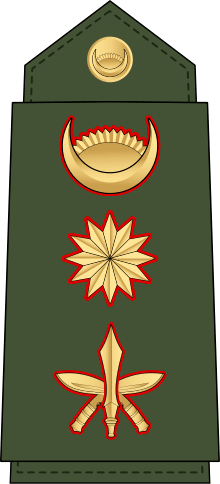
Officers
| Rank | English equivalent | Insignia | Description |
|---|---|---|---|
| Atirathi- अतिरथी | Field Marshal | – | Five-star rank |
| Pradhan Senapati – प्रधान सेनापति | General | Usually translated as "Chief of the Army Staff (COAS)". Army commander;four-star rank. | |
| Rathi – रथी | Lieutenant General | Held by the Chief of the General Staff (CGS) and the Chief of Staff (COS); Three-star rank.
| |
| Uparathi – उपरथी | Major General | Two-star rank:
| |
| Sahayakrathi – सहायक रथी | Brigadier General | Support Directorate, Combat Brigade or Combat Service Support Brigade commander; One-star rank | |
| Mahasenani – महासेनानी | Colonel | ||
| Pramukhsenani – प्रमुख सेनानी | Lieutenant Colonel | Battalion commander | |
| Senani – सेनानी | Major | Company commander | |
| Sahasenani – सह सेनानी | Captain | Company 2IC | |
| Upasenani – उप सेनानी | Lieutenant | Platoon leader | |
| Sahayaksenani – सहायक सेनानी | Second Lieutenant | ||
Junior Commissioned Officers(JCOs)/Warrant Officers
| Rank | English equivalent | Insignia | Description |
|---|---|---|---|
| Subedar Major – सुवेदार मेजर | Chief Warrant Officer | ||
| Subedar – सुवेदार | Warrant Officer 1 | ||
| Jamadar– जमदार | Warrant Officer 2 | ||
Non Commissioned Officers(NCOs) and Other Ranks
| Rank | English equivalent | Insignia | Description |
|---|---|---|---|
| Hudda- हुद्दा | Sergeant | Section leader | |
| Amaldar- अमल्दार | Corporal | Section 2IC | |
| Piuyth -प्युठ | Lance Corporal | ||
| Sipahi – सिपाही / Gunner गनर | Private | ||
| Followers – | Non-Combatants | ||
Chiefs of the Nepalese Army
The Chief of the Nepalese Army have been mostly drawn from noble Chhetri families from Gorkha such as "Pande dynasty", "Basnyat dynasty", and "Thapa dynasty" before the rule of "Rana dynasty".[23] During the Shah monarchy, the officers were drawn from these aristocratic families.[23] During the Rana dynasty, Ranas overtook the position as birthright.[23] The first army chief of Nepal was King Prithvi Narayan Shah who drafted and commanded the Nepali (Gorkhali) Army.[24] The first civilian army chief was Kaji Kalu Pande who had significant role in the campaign of Nepal.[24] He was considered as army head due to the undertaking of duties and responsibilities of the army but not by the formalization of the title.[24]
Mukhtiyar Bhimsen Thapa was the first person to use Commander-in-Chief as the title of army chief.[25] King Rajendra Bikram Shah appointed Bhimsen to the post of Commander-in-Chief and praised Bhimsen for long service to the nation.[26] However, on 14 June 1837, the King took over the command of all the battalions put in charge of various courtiers, and himself became the Commander-in-Chief.[27][28] Immediately after the incarceration of the Thapas in 1837, Dalbhanjan Pande and Rana Jang Pande were the joint head of military administration.[29] However, Rana Jang was removed after 3 months on October 1837.[30][31][32][33]
Since the regime of Mukhtiyar Bhimsen, only seven army chiefs of Nepal were non-Rana Chhetris including Shahs while others were all Ranas till 2007.[25] Commander-in-Chief (C-in-C) was replaced by Chief of the Army Staff (COAS) from the reign of General Singha Pratap Shah. Chief of the Army Staff is also known as Chief Saab.
List of Gorkhali Army Chiefs (1743 - 1835)
| No. | Name | Starting date | Ending Date | Remarks |
|---|---|---|---|---|
| - | King Prithvi Narayan Shah | 1743 | circa 1746 | |
| 1. | Kalu Pande | circa 1746 | June 1757 | First civilian army chief of Gorkhali forces. |
| 2. | Vamsharaj Pande | ?? | July 1785 | Probably, joint chief of army with others. |
| 3. | Abhiman Singh Basnyat | ?? | April 1794 | Probably, joint chief of army with others. |
| 4. | Damodar Pande | ?? | March 1804 | Probably, joint chief of army with others. |
| 5. | Bhimsen Thapa | 1811 | 1835 |
List of Commander-in-Chief of Nepal Army (1835 - 1979)
| No. | Name | Starting date | Ending Date | Remarks |
|---|---|---|---|---|
| 5. | Bhimsen Thapa | 1835 | 14 June 1837 | |
| - | King Rajendra Bikram Shah | 14 June 1837 | June 1837 | |
| 6. | Rana Jang Pande | June 1837 | October 1837 | |
| 7. | Mathabarsingh Thapa | November 1843 | 17 May 1845 | On 17 May, he was murdered. |
| 8. | Jung Bahadur Rana | 15 September 1846 | 1 August 1856 | |
| 9. | Bam Bahadur Kunwar | 1 August 1856 | 25 May 1857 | |
| 10. | Krishna Bahadur Kunwar | 25 May 1857 | 28 June 1857 | |
| 8. | Jung Bahadur Rana | 28 June 1857 | 25 February 1877 | |
| 11. | Ranodip Singh Kunwar | 27 February 1877 | 1877 | |
| 12. | Jagat Shamsher Kunwar Rana | 1877 | 1879 | |
| 13. | Dhir Shamsher Kunwar Rana | 1879 | 14 October 1884 | |
| 14. | Jeet Jang Rana | October 1884 | 22 November 1885 | On 22 November 1885, coup de etat occurred. |
| 15. | Khadga Shamsher Jang Bahadur Rana | 22 November 1885 | 13 March 1887 | |
| 16. | Rana Shamsher Jang Bahadur Rana | March 1887 | June 1887 | |
| 17. | Dev Shamsher Jang Bahadur Rana | June 1887 | 5 March 1901 | |
| 18. | Chandra Shamsher Jang Bahadur Rana | 5 March 1901 | 27 June 1901 | |
| 19. | Bhim Shamsher Jang Bahadur Rana | 27 June 1901 | 26 November 1929 | |
| 20. | Juddha Shamsher Jang Bahadur Rana | 26 November 1929 | 14 October 1932 | |
| 21. | Rudra Shamsher Jang Bahadur Rana | 14 October 1932 | 18 March 1934 | |
| 22. | Padma Shamsher Jang Bahadur Rana | 18 March 1934 | 29 November 1945 | |
| 23. | Mohan Shamsher Jang Bahadur Rana | 29 November 1945 | 30 April 1948 | |
| 24. | Baber Shamsher Jang Bahadur Rana | 30 April 1948 | 1951 | |
| 25. | Kaiser Shamsher Jang Bahadur Rana | 1951 | 1953 | |
| 26. | Kiran Shamsher Rana | 1953 | 1956 | |
| 27. | Toran Shamsher Jang Bahadur Rana | 1956 | 1960 | |
| 28. | Nir Shumsher Jang Bahadur Rana | 15 Baisakh, 2017 B.S (1960 A.D.) | 15 Baisakh 2022 B.S (1965 A.D.)[34] | |
| 29. | Surendra Bahadur Shah | 1965 | 1970 | |
| 30. | Singha Bahadur Basnyat | 1970 | 10 May 1975 | |
| 31. | Guna Shamsher Jang Bahadur Rana | 10 May 1975 | 10 May 1979 |
List of Chiefs of the Army Staff of Nepal (1979 – present)
| No. | Name | Starting Date | Ending Date | Unit of Commission | Remarks |
|---|---|---|---|---|---|
| 32. | Singha Pratap Shah | 15 May 1979 | 15 May 1983 | ||
| 33. | Arjun Narsingh Rana | 15 May 1983 | 15 May 1987 | ||
| 34. | Satchit Shumsher Jang Bahadur Rana | 15 May 1987 | 15 May 1991 | ||
| 35. | Gadul Shumsher Jang Bahadur Rana | 15 May 1991 | 4 May 1995[35] | ||
| 36. | Dharmapaal Barsingh Thapa | 15 May 1995 | 15 May 1999 | ||
| 37. | Prajwalla Shumsher Jang Bahadur Rana | 19 May 1999 | 9 September 2003 | ||
| 38. | Pyar Jung Thapa | 10 September 2003 | 9 September 2006 | ||
| 39. | Rookmangad Katawal | 9 September 2006 | 9 September 2009 | ||
| 40. | Chhatra Man Singh Gurung | 9 Sep 2009 | 5 Sep 2012 | First Janajati Army Chief | |
| 41. | Gaurav Shumsher JB Rana | 6 September 2012 | 10 September 2015 | ||
| 42. | Rajendra Chhetri | 10 September 2015 | 9 September 2018[4] | Rajdal Battalion | |
| 43. | Purna Chandra Thapa | 9 September 2018[36][37] | present | Gorakh Bahadur Battalion[38] |
Battles
Nepalese army fights various battles on the unification campaign these battles of Nepal unification help royal Nepalese army to gain more experiences with a gift of Unified Nepal.
Battles on Defending Kingdom of Nepal
- Battle against Mir Qasim – 1763 CE
- Battle of Pauwa Gadhi against Captain Kinloch- 1767 CE
- Anglo-Nepalese War – 1814 CE
- First Nepal – Tibet War
- Nepal-Tibet/China War
- Last Nepal-Tibet War
- Nepalese Civil War
Battles of Unification of Kingdom of Nepal
Battles as allies
Medals and awards
- Mahendra Mala
- Parama Nepal Pratap Baskara
- Ati Nepal Pratapa Bhaskara
- Nepal Pratapa Bhaskara
- Ojasvi Rajanya (Sovereign – A)
- Ojasvi Rajanya (Sovereign – B)
- Ojasvi Rajanya (Grand Master – A)
- Ojasvi Rajanya (Grand Master – B)
- Parama Ujjvala Keertimaya Nepal – Shreepada
- Ati Ujjvala Keertimaya Nepal – Shreepada
- Maha Ujjvala Keertimaya Nepal Shreepada
Social Adaptation
Nepal Army is portayed in different movies and teleshows throughout Nepal and world. The film "Ma Timi Bina Marihalchu Ni" featuring Bhuwan K.C. and Jharana Thapa is based on the story of Nepal Army.
See also
Notes
References
- ↑ "Nepal Military Strength". Archived from the original on 16 January 2016. Retrieved 23 October 2014.
- ↑ "Lamb6". Retrieved 23 October 2014.
- ↑ Haviland, Charles (2006-05-19). "Erasing the 'royal' in Nepal". BBC News. Retrieved 2006-09-23.
- 1 2 https://thehimalayantimes.com/kathmandu/lieutenant-general-purna-chandra-thapa-to-take-charge-of-nepali-army-as-acting-chief-of-army-staff/
- ↑ http://kathmandupost.ekantipur.com/news/2018-08-10/new-chief-faces-daunting-task-rebuilding-nepal-armys-image.html
- ↑ https://www.youtube.com/watch?v=l9Baj_IO_Ag
- ↑ "In a first, NA peacekeepers to dispose explosives under UN mission". Retrieved 23 October 2014.
- ↑ "NA to deploy 140 soldiers to Mali for peacekeeping – News – :: The Kathmandu Post ::". Retrieved 23 October 2014.
- ↑ http://kathmandupost.ekantipur.com/printedition/news/2013-03-09/nepal-army-day-five-nepal-army-battalions-mark-250-years-of-combat-history.html
- 1 2 3 4 5 6 7 8 9 10 11 12 13 14 15 "Legacies of War in the Company of Peace: Firearms in Nepal" (PDF). Geneva: Small Arms Survey. May 2013. Archived from the original (PDF) on 8 July 2014. Retrieved 21 September 2016.
- 1 2 3 4 5 6 7 8 9 Graduate Institute of International Studies (2003). Small Arms Survey 2003: Development Denied. Oxford: Oxford University Press. pp. 97–113. ISBN 978-0199251759.
- 1 2 3 4 5 6 7 Hogg, Ian (1991). Jane's Infantry Weapons (17 ed.). Macdonald and Jane's Publishers Ltd. p. 747. ISBN 978-0710609632.
- ↑ Sharma, Haridev (2012). Tripathi, Devi Prasad, ed. Nepal in Transition: A Way Forward. New Delhi: Vij Books India Pvt Ltd. p. 57. ISBN 978-9381411070.
- ↑ "Wikileaks news: Why Nepal king Gyanendra shed power". The Economic Times. 6 September 2011. Retrieved 29 May 2014.
- ↑ "Exercise Shanti Prayas III Closing Ceremony". DVIDS. Retrieved 2017-09-27.
- 1 2 Pretty, Ronald. Jane's Weapon Systems, 1983–84 (1983 ed.). Macdonald and Jane's Publishers Ltd. p. 876. ISBN 978-0-7106-0776-8.
- ↑ Christopher F. Foss. Jane's Armour and Artillery (2002 ed.). Macdonald and Jane's Publishers Ltd. p. 740. ISBN 978-0710623096.
- 1 2 3 4 5 6 7 8 "Trade Registers". Armstrade.sipri.org. Retrieved 2013-06-20.
- ↑ Leon Engelbrecht. "South African Arms Exports". Retrieved 5 November 2014.
- ↑ "Nepalnews.com". Nepalnews.com.
- ↑ "Organization". nepalarmy.mil.np.
- ↑ "Ranks". nepalarmy.mil.np. Archived from the original on 2015-09-01.
- 1 2 3 Adhikari 2012, p. 154.
- 1 2 3 Adhikari 2012, p. 153.
- 1 2 Adhikari 2012, p. 155.
- ↑ Pradhan 2012, p. 149.
- ↑ Acharya 2012, p. 215.
- ↑ Nepal 2007, p. 105.
- ↑ Nepal 2007, p. 106.
- ↑ Acharya 2012, p. 160.
- ↑ Oldfield 1880, p. 311.
- ↑ Nepal 2007, p. 109.
- ↑ Pradhan 2012, p. 164.
- ↑ "First Field Marshal Nir Shumsher passes away". Archived from the original on 2015-04-02.
- ↑ https://thehimalayantimes.com/kathmandu/former-nepal-army-chief-gadul-shamsher-rana-no-more/
- ↑ https://economictimes.indiatimes.com/news/defence/general-purna-thapa-is-new-chief-of-nepal-army/articleshow/65740999.cms
- ↑ http://kathmandupost.ekantipur.com/news/2018-09-10/thapa-sworn-in-as-new-army-chief.html
- ↑ https://thehimalayantimes.com/kathmandu/purna-chandra-thapa-likely-appointed-nepali-army-chief/
Books
- Acharya, Baburam (2012), Acharya, Shri Krishna, ed., Janaral Bhimsen Thapa : Yinko Utthan Tatha Pattan (in Nepali), Kathmandu: Education Book House, p. 228, ISBN 9789937241748
- Adhikari, Indra (2015), Military and Democracy in Nepal, Routledge, ISBN 9781317589068
- Nepal, Gyanmani (2007), Nepal ko Mahabharat (in Nepali) (3rd ed.), Kathmandu: Sajha, p. 314, ISBN 9789993325857
- Oldfield, Henry Ambrose (1880), Sketches from Nipal, Vol 1, 1, London: W.H. Allan & Co.
- Pradhan, Kumar L. (2012), Thapa Politics in Nepal: With Special Reference to Bhim Sen Thapa, 1806–1839, New Delhi: Concept Publishing Company, p. 278, ISBN 9788180698132
External links
- Official website of the Nepalese Army
- Official website of the Nepalese Army Command and Staff College
- Nepal
- Background Note: Nepal
- Nepal
- List of photographs of 49 Nepalese army generals
- http://thediplomat.com/2013/10/the-deft-politicking-of-nepals-army/1/, 2013
- Ghimire, S. (2016). Security Sector Reform Organic: Infrastructure for Peace as an Entry Point? Peacebuilding.
